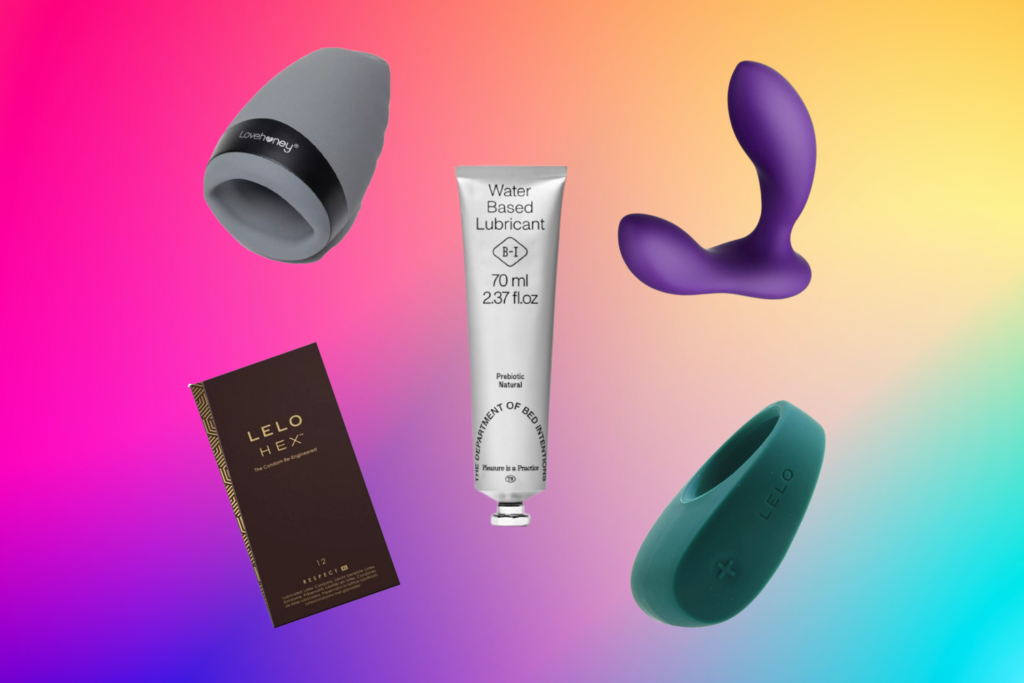WE TEND TO JUDGE how “good” we are in bed by how frequently we make our partner(s) orgasm. That’s not necessarily accurate—since sexual pleasure is about way more than orgasm—but still, it can be disappointing for everyone involved when you climax and your partner doesn’t.
Unfortunately, it happens more than it should. Ever heard of the “orgasm gap”? The term refers to the proven fact that straight, cis men orgasm during sex significantly more often than their partners do. A 2017 study published in the Archives of Sexual Behaviour found that these men orgasm 95 per cent of the time, whereas straight, cis women only orgasm 65 per cent of the time. The disparity has nothing to do with vulva owners’ anatomy; that same study found that cisgender lesbians orgasm 86 per cent of the time during sex, and additional research shows that vulva owners have no problem reaching orgasm during masturbation.
When it comes to making your partner orgasm, the key is thinking beyond intercourse alone. A 2020 study published in the Journal of Sexual Medicine found that it took between 12.76 and 14.06 minutes for the average vulva owner to reach climax during penetrative sex—roughly double the 5 to 7 minutes it typically takes penis-owners. And fewer than 1 in 5 vulva-owners are able to orgasm from penetration alone, according to the Mayo Clinic.
So how can you help your partner reach orgasm? Before you make it your life’s mission, a quick warning: While orgasms feel amazing, the act of chasing them can add a lot of pressure to your sex life. Recent research has focused on “orgasm coercion”: the idea that trying too hard to make your partner come can put pressure on them, which feels like coercion. People on the receiving end of orgasm coercion may feel like their climax is more about their partner’s need to feel “man enough” than it is about their pleasure. Talk to your partner to see if they feel this way. If they do, discuss what you can do to help take the pressure off.
How to make your partner orgasm
With all that said, let’s talk orgasms. If you want to help your partner climax—or make their orgasms even better than they already are—try these tips from sexual health experts.
1) Don’t race toward your partner’s orgasm
“Try to remember the goal of sex is pleasure, and orgasm is one kind of pleasure that is significantly shorter than all the rest of it,” says Shadeen Francis, LMFT. That’s why Francis recommends slowing down. Take your time with your movements, and don’t focus on the end game. There is a slight irony to it—the more your partner thinks about orgasming, the less likely they will be to orgasm. So take the pressure off of your partner and focus on making them feel as good as possible for as long as possible. (We refer to this slow-down technique as closing the “pleasure gap.”)
2) Incorporate external clitoral stimulation
First thing’s first: the vast majority of vulva-owners require external clitoral stimulation to reach orgasm. In fact, a study of more than 1,000 vulva-owners in 2017 revealed that only 18% of participants could orgasm through vaginal intercourse alone. So when you’re having sex, you want to focus on external stimulation alone or in combination with some form of penetration.
If you want to stimulate your partner’s clitoris during P-in-V intercourse, some sex positions make it easier to do than others. Rachel* is a fan of the coital alignment technique, or CAT: “When a guy is on top of you in the missionary position, have him shift his body slightly forward so that, every time he thrusts, his penis rubs against your clitoris.” This tactic is even more orgasmic if your partner’s legs are together and you’re straddling them, says Ellen Friedrichs, M.A., a health educator who also teaches at the City University of New York’s City Tech campus. You can achieve the same effect when they’re on top by propping yourself up on your elbows, which places your abdomen in closer contact with their clitoris.
3) Opt for specific positions
Speaking of the clitoris, there are some sex positions that come out on top (see what we did there?) when it comes to providing that sought-after stimulation.
According to Gigi Engle, SKYN’s resident sex expert, one of the best sex positions for clitoral contact is the lotus. In this position, you start seated and cross-legged, while your vulva-owning partner sits on your lap facing you and wraps their legs around your back. For a slightly less strenuous modification, you can also try the lotus position seated in a chair.
Engle likes this position because, like with the coital alignment technique, it entails sliding back and forth rather than bouncing up and down.
“It allows for more grinding against your partner’s body for that good old external stimulation,” she Engle.
Rebecca Glass, LMSW, a sex and relationship therapist, notes that cowgirl and reverse cowgirl are also stellar positions for getting some clitoral contact because the vulva owner has complete control over the angle of penetration.
4) Pay more attention to their butt
Unless anal is on the menu, butts are typically sidelined during sex. And that’s a shame, because “the buttocks are packed with nerve endings,” says Gilda Carle, Ph.D., an internationally-known relationship expert. To give your partner “a surprising jolt of pleasure,” spread your fingers wide and squeeze their cheeks.
That said, you should ask your partner if they’re into booty squeezing first. If they’re down, be gentle, and take it one step at a time. Yes, of course, there are people out there who crave a good, hard spanking, but that needs to be discussed and agreed on before the butt smacking begins.
5) Learn what your partner likes, and follow their lead
As we mentioned above, direct, external clitoral stimulation is the most surefire way to bring many vulva-owners to orgasm—and oral sex is a pretty good way of going about that. Sex therapist Ian Kerner, Ph.D., LMFT, says that using your mouth is the best way to get a sense of what your partner likes at every stage of arousal, including the stage just before orgasm. You’ll know your partner is becoming more aroused if you notice increased vaginal lubrication or if the external portion of their clitoris or their entire vulva swells. The clitoris—including the wishbone-shaped portion that’s underneath the skin—is made of erectile tissue just like the penis, so if your partner’s genitals increase in size, you’re doing a good job!
To find out more about your partner’s preferences, let them take the lead. When you’re giving them oral sex, get between their legs and give them a solid base of lips, tongue, and even chin (if you have a clean, smooth shave, that is) to rub against. While your partner does the grinding, note how hard they’re pushing and in what direction. Use that information later when using your fingers or mouth to please them.
6) Don’t stop kissing them
Once things get more heated, you might be tempted to focus less on kissing in favour of more X-rated pleasures. But deep kissing is often a must for reaching orgasm, according to a 2017 survey of more than 50,000 adults. The findings revealed that vulva-owners were much more likely to reach orgasm if their sexual encounter included a combination of deep kissing, oral sex, and genital stimulation.
7) Indulge their fantasies
Ask your partner if they have any fantasies they’d like to explore. “Fantasies can increase arousal during a sexual experience,” says Francis. “Finding a fantasy that really turns your partner on can add another layer of pleasure during sex.” It’s also a way to get your partner more psychologically aroused, which is just as important (if not more important) than physical arousal when it comes to having an orgasm. One study found that vulva-owners with lower sexual desire tend to require mental arousal in order to recognise their physical arousal. Try role play or tell your partner an erotic story to kick their pleasure up a notch.
8) Talk dirty to them
“Dirty talk” doesn’t have to include four-letter words. Describe what you’re doing to your partner, or say what you want them to do to you. If you’re hesitant, a simple compliment about how attractive you find your partner will do the trick. And if your partner has told you in advance that they’re turned on by specific words and phrases, pepper those into the dialogue, too.
9) Lube up
No matter how hot and heavy you’re getting, without adequate lubrication, it’s easy for sex to become uncomfortable or even painful for your partner. While lube is absolutely necessary for anal sex (butts don’t self-lubricate like vaginas do), it’s helpful for vaginal penetration and external stimulation, too—it can even make fingering more pleasurable. “Lubrication increases the comfort and speed with which you can penetrate the vagina and grind against the clitoris,” says Friedrichs.
Remember that needing lube doesn’t mean your partner isn’t turned on—some bodies just get wetter than others. Plus, medication, hormonal imbalances, menopause, stress, and dehydration can all decrease the body’s natural lubrication, so there’s nothing wrong with needing a little extra slippery stuff. Using lube makes sex more comfortable for everyone involved. In fact, a 2011 study found that using lube enhances sexual pleasure for vulva-owners. Just remember that if you’re using condoms, you should stick with water-based or silicone-based lube, since oil-based lube can damage latex.
















